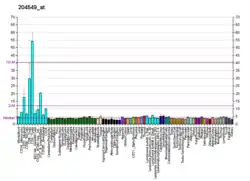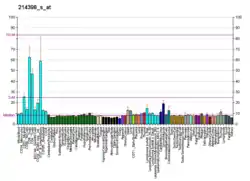IKBKE
Inhibitor of nuclear factor kappa-B kinase subunit epsilon also known as I-kappa-B kinase epsilon or IKK-epsilon is an enzyme that in humans is encoded by the IKBKE gene.[5][6][7]
Function
It is a Serine/threonine kinase that plays an essential role in regulating inflammatory responses to viral infection, through the activation of the type I IFN, NF-kappa-B and STAT signaling. Also involved in TNFA and inflammatory cytokines, like Interleukin-1, signaling. Following activation of viral RNA sensors, such as RIG-I-like receptors, associates with DDX3X and phosphorylates interferon regulatory factors (IRFs), IRF3 and IRF7, as well as DDX3X. This activity allows subsequent homodimerization and nuclear translocation of the IRF3 leading to transcriptional activation of pro-inflammatory and antiviral genes including IFNB. In order to establish such an antiviral state, IKBKE forms several different complexes whose composition depends on the type of cell and cellular stimuli. Thus, several scaffolding molecules including IPS1/MAVS, TANK, AZI2/NAP1 or TBKBP1/SINTBAD (TANK-binding kinase 1-binding protein 1) can be recruited to the IKBKE-containing-complexes. Activated by polyubiquitination in response to TNFA and interleukin-1, regulates the NF-kappa-B signaling pathway through, at least, the phosphorylation of CYLD. Phosphorylates inhibitors of NF-kappa-B thus leading to the dissociation of the inhibitor/NF-kappa-B complex and ultimately the degradation of the inhibitor. In addition, is also required for the induction of a subset of ISGs which displays antiviral activity, may be through the phosphorylation of STAT1 at 'Ser-708'. Phosphorylation of STAT1 at 'Ser-708' seems also to promote the assembly and DNA binding of ISGF3 (STAT1:STAT2:IRF9) complexes compared to GAF (gamma-activation factor) (STAT1:STAT1) complexes, in this way regulating the balance between type I and type II IFN responses. Protects cells against DNA damage-induced cell death. Also plays an important role in energy balance regulation by sustaining a state of chronic, low-grade inflammation in obesity, which leads to a negative impact on insulin sensitivity. Phosphorylates AKT1.[9]
Clinical significance
Inhibition of IκB kinase (IKK) and IKK-related kinases, IKBKE (IKKε) and TANK-binding kinase 1 (TBK1), has been investigated as a therapeutic option for the treatment of inflammatory diseases and cancer.[10]
References
- GRCh38: Ensembl release 89: ENSG00000263528 - Ensembl, May 2017
- GRCm38: Ensembl release 89: ENSMUSG00000042349 - Ensembl, May 2017
- "Human PubMed Reference:". National Center for Biotechnology Information, U.S. National Library of Medicine.
- "Mouse PubMed Reference:". National Center for Biotechnology Information, U.S. National Library of Medicine.
- Shimada T, Kawai T, Takeda K, Matsumoto M, Inoue J, Tatsumi Y, Kanamaru A, Akira S (September 1999). "IKK-i, a novel lipopolysaccharide-inducible kinase that is related to IkappaB kinases". Int Immunol. 11 (8): 1357–62. doi:10.1093/intimm/11.8.1357. PMID 10421793.
- Peters RT, Liao SM, Maniatis T (July 2000). "IKKepsilon is part of a novel PMA-inducible IkappaB kinase complex". Mol Cell. 5 (3): 513–22. doi:10.1016/S1097-2765(00)80445-1. PMID 10882136.
- "Entrez Gene: IKBKE inhibitor of kappa light polypeptide gene enhancer in B-cells, kinase epsilon".
- Nomura F, Kawai T, Nakanishi K, Akira S (March 2000). "NF-kappaB activation through IKK-i-dependent I-TRAF/TANK phosphorylation". Genes Cells. 5 (3): 191–202. doi:10.1046/j.1365-2443.2000.00315.x. PMID 10759890. S2CID 8489218.
- "Inhibitor of nuclear factor kappa-B kinase subunit epsilon". Cite journal requires
|journal=(help) - Llona-Minguez S, Baiget J, Mackay SP (2013). "Small-molecule inhibitors of IκB kinase (IKK) and IKK-related kinases". Pharm. Pat. Anal. 2 (4): 481–498. doi:10.4155/ppa.13.31. PMID 24237125.
Further reading
- Mercurio AM (2003). "Invasive skin carcinoma--Ras and alpha6beta4 integrin lead the way". Cancer Cell. 3 (3): 201–2. doi:10.1016/S1535-6108(03)00049-7. PMID 12676577.
- Nagase T, Seki N, Tanaka A, et al. (1996). "Prediction of the coding sequences of unidentified human genes. IV. The coding sequences of 40 new genes (KIAA0121-KIAA0160) deduced by analysis of cDNA clones from human cell line KG-1". DNA Res. 2 (4): 167–74, 199–210. doi:10.1093/dnares/2.4.167. PMID 8590280.
- Nomura F, Kawai T, Nakanishi K, Akira S (2000). "NF-kappaB activation through IKK-i-dependent I-TRAF/TANK phosphorylation". Genes Cells. 5 (3): 191–202. doi:10.1046/j.1365-2443.2000.00315.x. PMID 10759890. S2CID 8489218.
- Miller BS, Zandi E (2001). "Complete reconstitution of human IkappaB kinase (IKK) complex in yeast. Assessment of its stoichiometry and the role of IKKgamma on the complex activity in the absence of stimulation". J. Biol. Chem. 276 (39): 36320–6. doi:10.1074/jbc.M104051200. PMID 11470787.
- Kishore N, Huynh QK, Mathialagan S, et al. (2002). "IKK-i and TBK-1 are enzymatically distinct from the homologous enzyme IKK-2: comparative analysis of recombinant human IKK-i, TBK-1, and IKK-2". J. Biol. Chem. 277 (16): 13840–7. doi:10.1074/jbc.M110474200. PMID 11839743.
- Aupperle KR, Yamanishi Y, Bennett BL, et al. (2002). "Expression and regulation of inducible IkappaB kinase (IKK-i) in human fibroblast-like synoviocytes". Cell. Immunol. 214 (1): 54–9. doi:10.1006/cimm.2002.1885. PMID 11902829.
- Bossis G, Salinas S, Cartier C, et al. (2002). "NF-kappaB activation upon interaction of HIV-1 envelope glycoproteins with cell surface CD4 involves IkappaB kinases". FEBS Lett. 516 (1–3): 257–64. doi:10.1016/S0014-5793(02)02566-8. PMID 11959143. S2CID 85429565.
- Chariot A, Leonardi A, Muller J, et al. (2002). "Association of the adaptor TANK with the I kappa B kinase (IKK) regulator NEMO connects IKK complexes with IKK epsilon and TBK1 kinases". J. Biol. Chem. 277 (40): 37029–36. doi:10.1074/jbc.M205069200. PMID 12133833.
- Strausberg RL, Feingold EA, Grouse LH, et al. (2003). "Generation and initial analysis of more than 15,000 full-length human and mouse cDNA sequences". Proc. Natl. Acad. Sci. U.S.A. 99 (26): 16899–903. doi:10.1073/pnas.242603899. PMC 139241. PMID 12477932.
- Fitzgerald KA, McWhirter SM, Faia KL, et al. (2003). "IKKepsilon and TBK1 are essential components of the IRF3 signaling pathway". Nat. Immunol. 4 (5): 491–6. doi:10.1038/ni921. PMID 12692549. S2CID 19867234.
- Kravchenko VV, Mathison JC, Schwamborn K, et al. (2003). "IKKi/IKKepsilon plays a key role in integrating signals induced by pro-inflammatory stimuli". J. Biol. Chem. 278 (29): 26612–9. doi:10.1074/jbc.M303001200. PMID 12736252.
- Matsuda A, Suzuki Y, Honda G, et al. (2003). "Large-scale identification and characterization of human genes that activate NF-kappaB and MAPK signaling pathways". Oncogene. 22 (21): 3307–18. doi:10.1038/sj.onc.1206406. PMID 12761501.
- Fujita F, Taniguchi Y, Kato T, et al. (2003). "Identification of NAP1, a regulatory subunit of IkappaB kinase-related kinases that potentiates NF-kappaB signaling". Mol. Cell. Biol. 23 (21): 7780–93. doi:10.1128/MCB.23.21.7780-7793.2003. PMC 207563. PMID 14560022.
- Ota T, Suzuki Y, Nishikawa T, et al. (2004). "Complete sequencing and characterization of 21,243 full-length human cDNAs". Nat. Genet. 36 (1): 40–5. doi:10.1038/ng1285. PMID 14702039.
- Bouwmeester T, Bauch A, Ruffner H, et al. (2004). "A physical and functional map of the human TNF-alpha/NF-kappa B signal transduction pathway". Nat. Cell Biol. 6 (2): 97–105. doi:10.1038/ncb1086. PMID 14743216. S2CID 11683986.
- tenOever BR, Sharma S, Zou W, et al. (2004). "Activation of TBK1 and IKKvarepsilon kinases by vesicular stomatitis virus infection and the role of viral ribonucleoprotein in the development of interferon antiviral immunity". J. Virol. 78 (19): 10636–49. doi:10.1128/JVI.78.19.10636-10649.2004. PMC 516426. PMID 15367631.
- Buss H, Dörrie A, Schmitz ML, et al. (2005). "Constitutive and interleukin-1-inducible phosphorylation of p65 NF-{kappa}B at serine 536 is mediated by multiple protein kinases including I{kappa}B kinase (IKK)-{alpha}, IKK{beta}, IKK{epsilon}, TRAF family member-associated (TANK)-binding kinase 1 (TBK1), and an unknown kinase and couples p65 to TATA-binding protein-associated factor II31-mediated interleukin-8 transcription". J. Biol. Chem. 279 (53): 55633–43. doi:10.1074/jbc.M409825200. PMID 15489227.
- "Inhibitor of nuclear factor kappa-B kinase subunit epsilon". Cite journal requires
|journal=(help)





